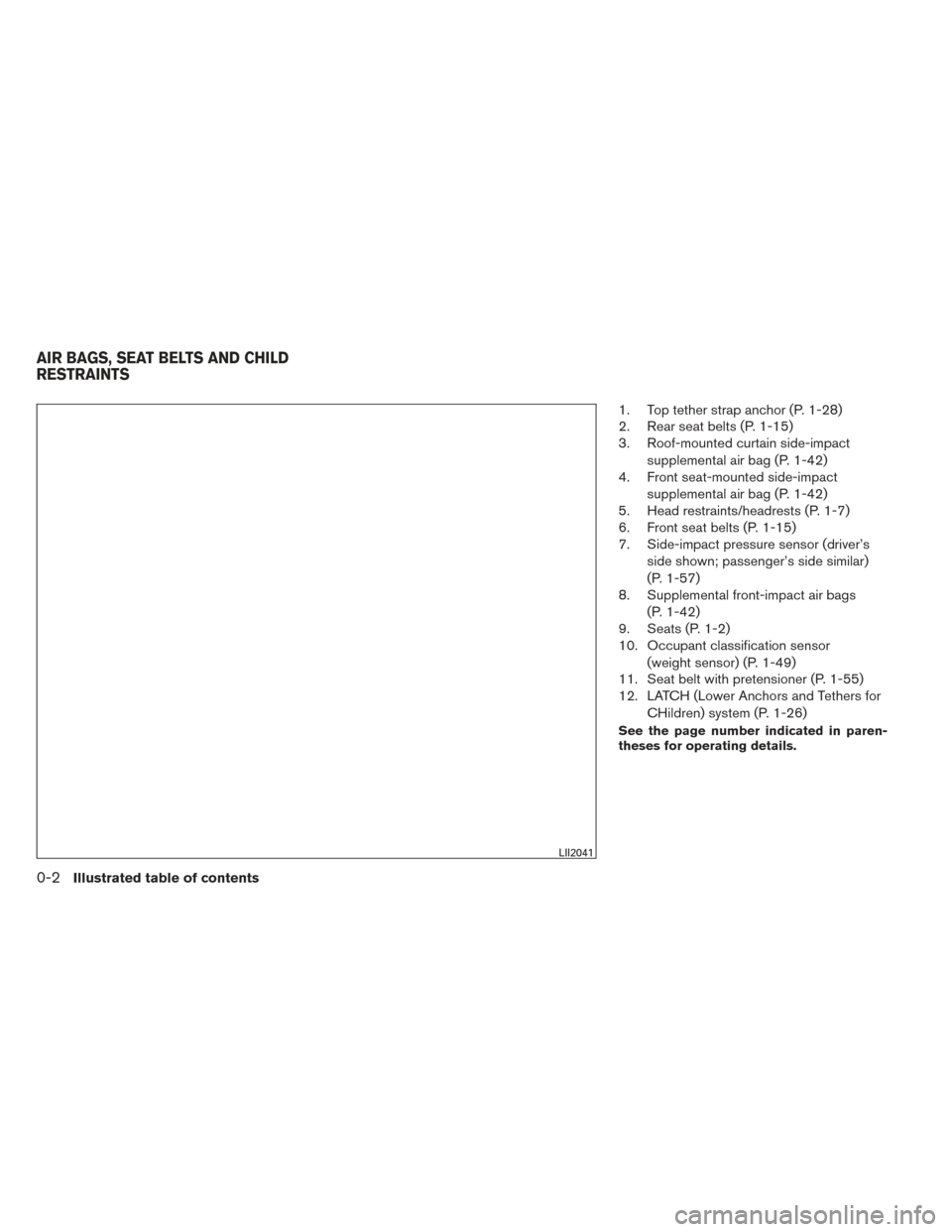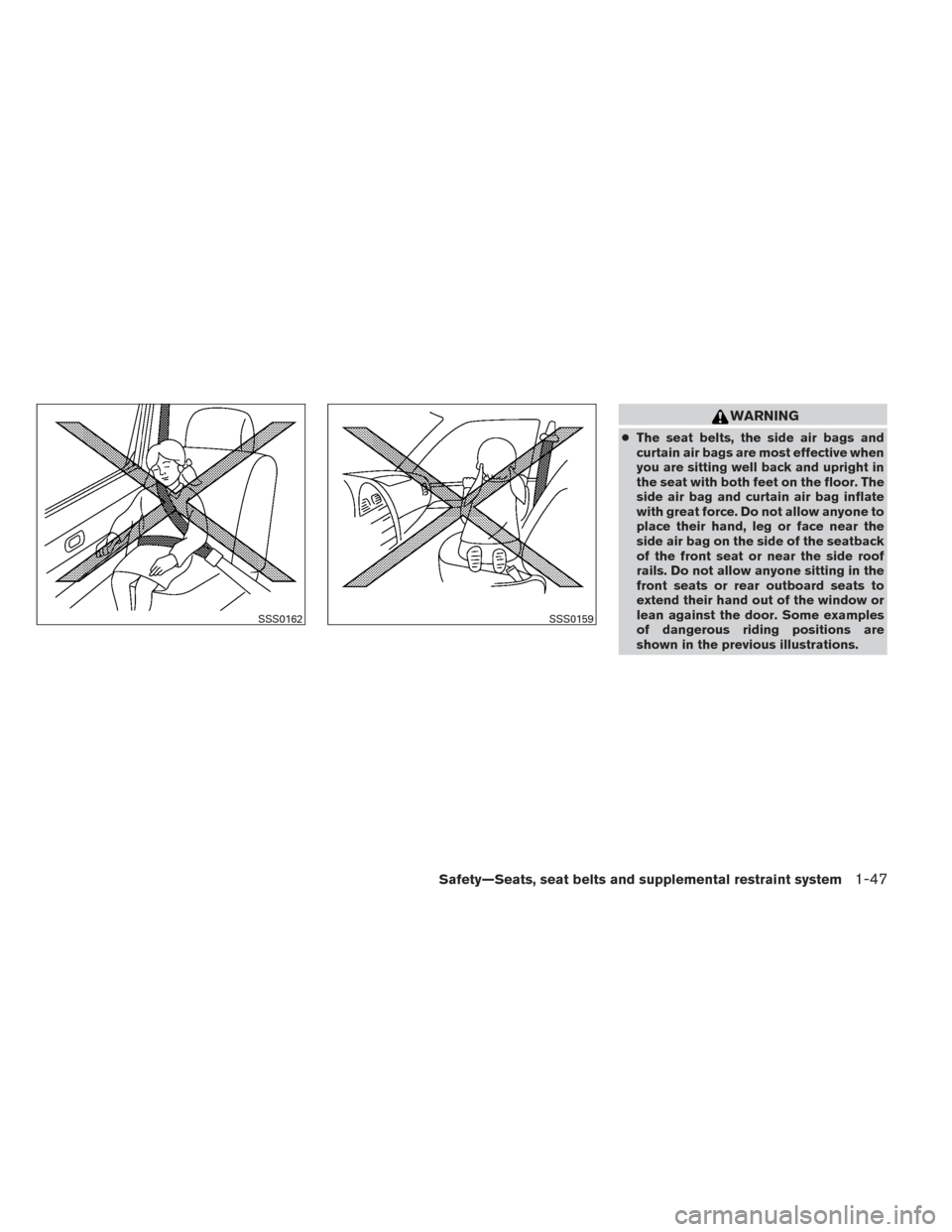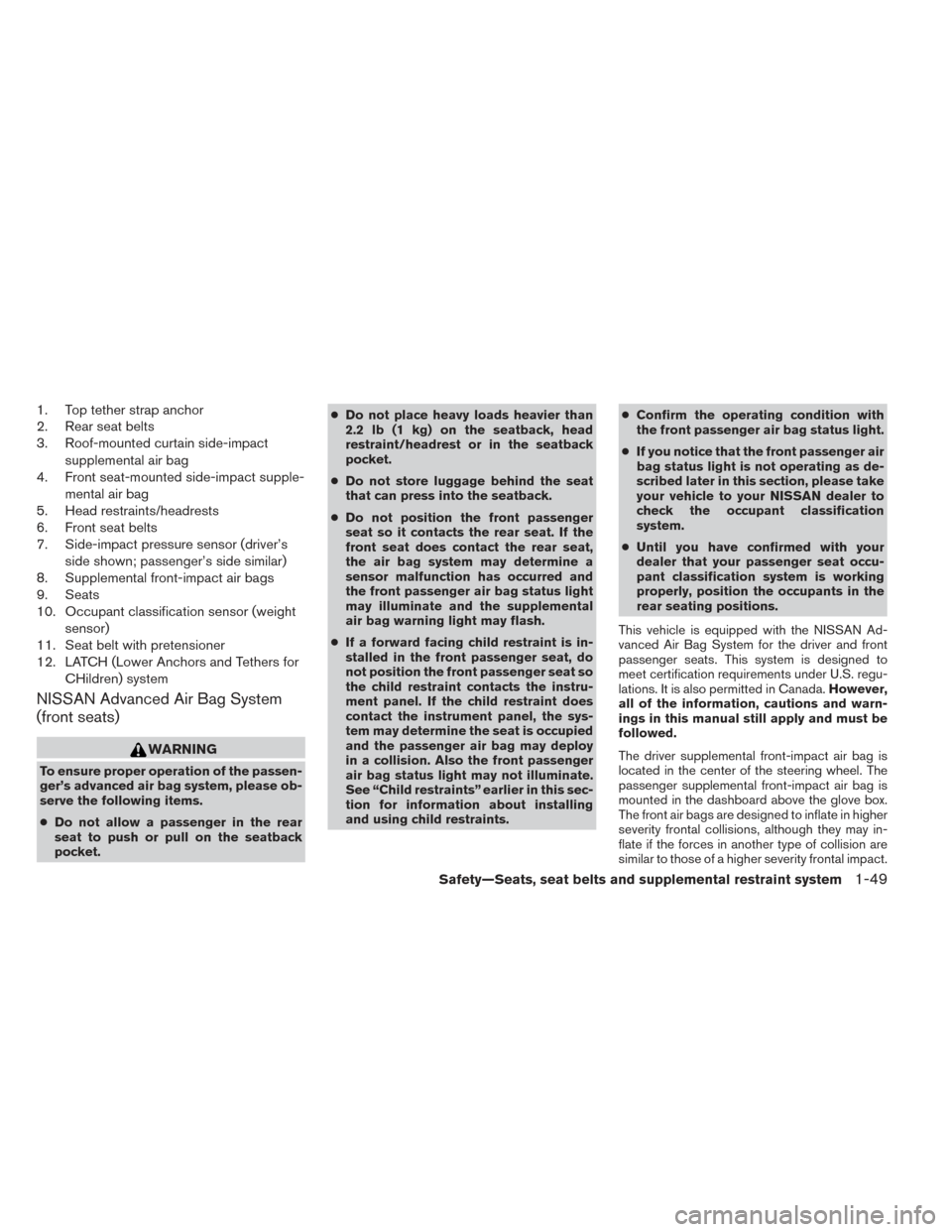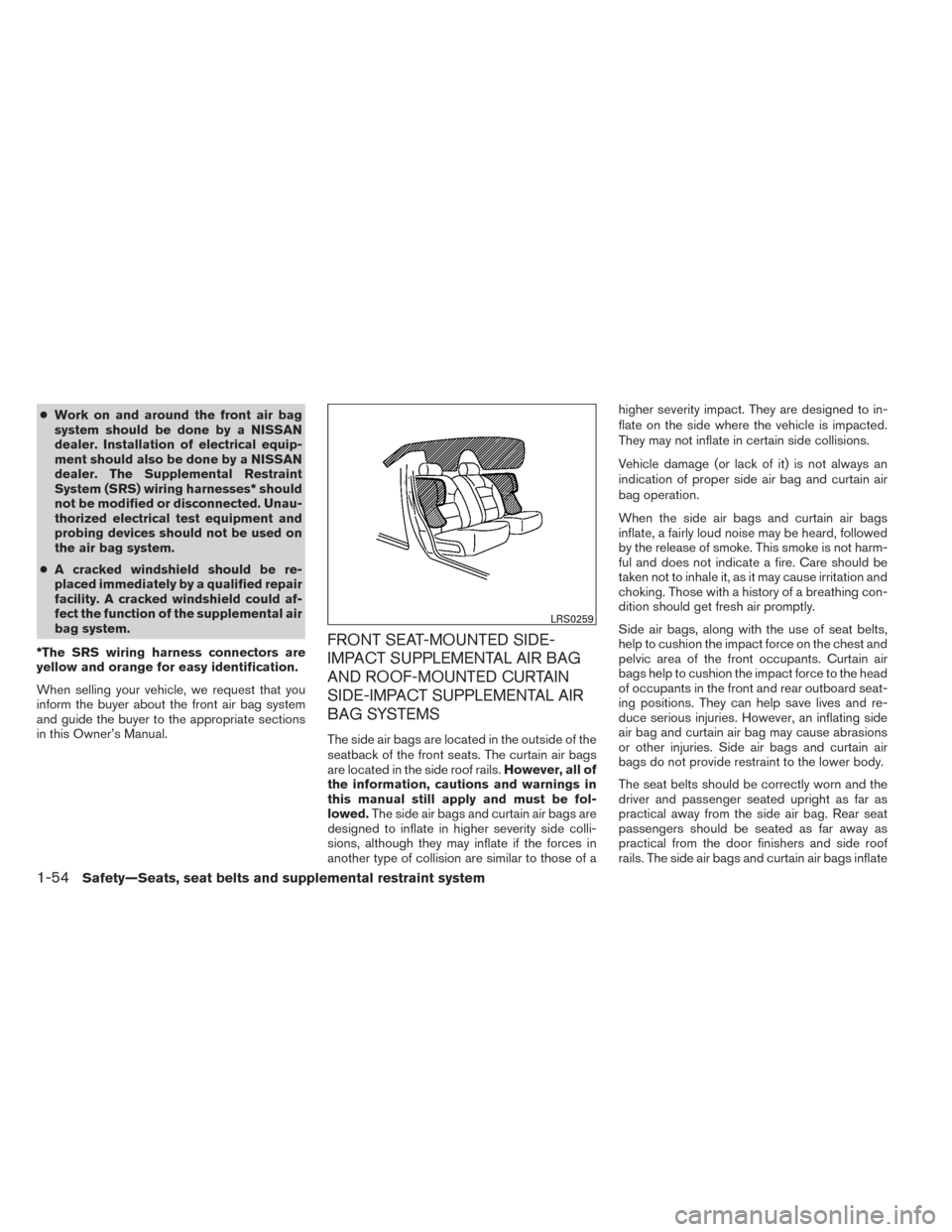2014 NISSAN ALTIMA roof
[x] Cancel search: roofPage 9 of 428

1. Top tether strap anchor (P. 1-28)
2. Rear seat belts (P. 1-15)
3. Roof-mounted curtain side-impactsupplemental air bag (P. 1-42)
4. Front seat-mounted side-impact
supplemental air bag (P. 1-42)
5. Head restraints/headrests (P. 1-7)
6. Front seat belts (P. 1-15)
7. Side-impact pressure sensor (driver’s
side shown; passenger’s side similar)
(P. 1-57)
8. Supplemental front-impact air bags
(P. 1-42)
9. Seats (P. 1-2)
10. Occupant classification sensor
(weight sensor) (P. 1-49)
11. Seat belt with pretensioner (P. 1-55)
12. LATCH (Lower Anchors and Tethers for
CHildren) system (P. 1-26)
See the page number indicated in paren-
theses for operating details.
LII2041
AIR BAGS, SEAT BELTS AND CHILD
RESTRAINTS
0-2Illustrated table of contents
Page 12 of 428

1. Interior trunk access (P. 1-5)
2. Moonroof (if so equipped) (P. 2-46)
3. Sun visors (P. 3-34)
4. Interior lights, illuminated entry (P. 2-48)
5. HomeLink® universal transceiver(if so equipped) (P. 2-50)
6. Automatic anti-glare rearview mirror
(if so equipped) (P. 3-35)
7. Glove box (P. 2-42)
8. Cup holders (P. 2-41 )
9. Console box (P. 2-42)
10. Front seat (P. 1-2)
11. Rear seat (P. 1-5)
See the page number indicated in paren-
theses for operating details.
LII2040
PASSENGER COMPARTMENT
Illustrated table of contents0-5
Page 18 of 428

1 Safety—Seats, seat belts and
supplemental restraint system
Seats ............................................1-2
Front manual seat adjustment
(if so equipped) ................................1-2
Front power seat adjustment
(if so equipped for driver’s seat) ..................1-4
Folding rear seat ...............................1-5
Front seat head restraints/headrests ..............1-7
Rear seat head restraints/headrests .............1-11
Seat belts ....................................... 1-15
Precautions on seat belt usage ..................1-15
Pregnant women .............................. 1-18
Injured persons ................................ 1-18
Three-point type seat belt with retractor ..........1-18
Seat belt extenders ............................ 1-21
Seat belt maintenance ......................... 1-22
Child safety ...................................... 1-22
Infants ........................................ 1-23
Small children ................................. 1-23
Larger children ................................ 1-23
Child restraints ................................... 1-24
Precautions on child restraints ..................1-24LATCH (Lower Anchors and Tethers for
CHildren) System
............................. 1-26
Rear-facing child restraint installation using
LATCH....................................... 1-28
Rear-facing child restraint installation using
the seat belts . . ............................... 1-30
Forward-facing child restraint installation
using LATCH. . . ............................... 1-33
Forward-facing child restraint installation
using the seat belts ............................ 1-35
Installing top tether strap .......................1-38
Booster seats ................................. 1-39
Supplemental restraint system .....................1-42
Precautions on supplemental restraint
system ....................................... 1-42
Front seat-mounted side-impact
supplemental air bag and roof-mounted
curtain side-impact supplemental air bag
systems ...................................... 1-54
Seat belts with pretensioners (Front seats) .......1-55
Supplemental air bag warning labels .............1-56
Supplemental air bag warning light ..............1-57
Page 59 of 428

7. If the booster seat is installed in the frontpassenger seat, place the ignition switch in
the ON position. The front passenger air bag
status light
may or may not illuminate,
depending on the size of the child and the
type of booster seat being used. See “Front
passenger air bag and status light” later in
this section.
PRECAUTIONS ON SUPPLEMENTAL
RESTRAINT SYSTEM
This Supplemental Restraint System (SRS) sec-
tion contains important information concerning
the following systems:
● Driver and passenger supplemental front-
impact air bag (NISSAN Advanced Air Bag
System)
● Front seat-mounted side-impact supple-
mental air bag
● Roof-mounted curtain side-impact supple-
mental air bag
● Seat belt with pretensioner
Supplemental front-impact air bag system:
The NISSAN Advanced Air Bag System can help
cushion the impact force to the head and chest of
the driver and front passenger in certain frontal
collisions.
Front seat-mounted side-impact supple-
mental air bag system: This system can help
cushion the impact force to the chest area of the
driver and front passenger in certain side-impact
collisions. The side air bags are designed to
inflate on the side where the vehicle is impacted. Roof-mounted curtain side-impact supple-
mental air bag system:
This system can help
cushion the impact force to the head of occu-
pants in front and rear outboard seating positions
in certain side-impact collisions. The curtain air
bags are designed to inflate on the side where
the vehicle is impacted.
These supplemental restraint systems are de-
signed to supplement the crash protection pro-
vided by the driver and front passenger seat belts
and are not a substitute for them. Seat belts
should always be correctly worn and the occu-
pant seated a suitable distance away from the
steering wheel, instrument panel and door finish-
ers. See “Seat belts” earlier in this section for
instructions and precautions on seat belt usage.
The supplemental air bags operate only
when the ignition switch is placed in the ON
position.
After placing the ignition switch in the ON
position, the supplemental air bag warning
light illuminates. The supplemental air bag
warning light will turn off after about 7 sec-
onds if the system is operational.
WRS0475
SUPPLEMENTAL RESTRAINT
SYSTEM
1-42Safety—Seats, seat belts and supplemental restraint system
Page 63 of 428

WARNING
●Children may be severely injured or
killed when the front air bags, side air
bags or curtain air bags inflate if they
are not properly restrained. Pre-teens
and children should be properly re-
strained in the rear seat, if possible.
● Even with the NISSAN Advanced Air
Bag System, never install a rear-facing
child restraint in the front seat. An in-
flating front air bag could seriously in-
jure or kill your child. See “Child re-
straints” earlier in this section for
details.
WARNING
Front seat-mounted side-impact supple-
mental air bags and roof-mounted curtain
side-impact supplemental air bags:
● The side air bags and curtain air bags
ordinarily will not inflate in the event of
a frontal impact, rear impact, rollover or
lower severity side collision. Always
wear your seat belts to help reduce the
risk or severity of injury in various kinds
of accidents.
ARS1045ARS1046WRS0431
1-46Safety—Seats, seat belts and supplemental restraint system
Page 64 of 428

WARNING
●The seat belts, the side air bags and
curtain air bags are most effective when
you are sitting well back and upright in
the seat with both feet on the floor. The
side air bag and curtain air bag inflate
with great force. Do not allow anyone to
place their hand, leg or face near the
side air bag on the side of the seatback
of the front seat or near the side roof
rails. Do not allow anyone sitting in the
front seats or rear outboard seats to
extend their hand out of the window or
lean against the door. Some examples
of dangerous riding positions are
shown in the previous illustrations.
SSS0162SSS0159
Safety—Seats, seat belts and supplemental restraint system1-47
Page 66 of 428

1. Top tether strap anchor
2. Rear seat belts
3. Roof-mounted curtain side-impactsupplemental air bag
4. Front seat-mounted side-impact supple-
mental air bag
5. Head restraints/headrests
6. Front seat belts
7. Side-impact pressure sensor (driver’s
side shown; passenger’s side similar)
8. Supplemental front-impact air bags
9. Seats
10. Occupant classification sensor (weight
sensor)
11. Seat belt with pretensioner
12. LATCH (Lower Anchors and Tethers for
CHildren) system
NISSAN Advanced Air Bag System
(front seats)
WARNING
To ensure proper operation of the passen-
ger’s advanced air bag system, please ob-
serve the following items.
●Do not allow a passenger in the rear
seat to push or pull on the seatback
pocket. ●
Do not place heavy loads heavier than
2.2 lb (1 kg) on the seatback, head
restraint/headrest or in the seatback
pocket.
● Do not store luggage behind the seat
that can press into the seatback.
● Do not position the front passenger
seat so it contacts the rear seat. If the
front seat does contact the rear seat,
the air bag system may determine a
sensor malfunction has occurred and
the front passenger air bag status light
may illuminate and the supplemental
air bag warning light may flash.
● If a forward facing child restraint is in-
stalled in the front passenger seat, do
not position the front passenger seat so
the child restraint contacts the instru-
ment panel. If the child restraint does
contact the instrument panel, the sys-
tem may determine the seat is occupied
and the passenger air bag may deploy
in a collision. Also the front passenger
air bag status light may not illuminate.
See “Child restraints” earlier in this sec-
tion for information about installing
and using child restraints. ●
Confirm the operating condition with
the front passenger air bag status light.
● If you notice that the front passenger air
bag status light is not operating as de-
scribed later in this section, please take
your vehicle to your NISSAN dealer to
check the occupant classification
system.
● Until you have confirmed with your
dealer that your passenger seat occu-
pant classification system is working
properly, position the occupants in the
rear seating positions.
This vehicle is equipped with the NISSAN Ad-
vanced Air Bag System for the driver and front
passenger seats. This system is designed to
meet certification requirements under U.S. regu-
lations. It is also permitted in Canada. However,
all of the information, cautions and warn-
ings in this manual still apply and must be
followed.
The driver supplemental front-impact air bag is
located in the center of the steering wheel. The
passenger supplemental front-impact air bag is
mounted in the dashboard above the glove box.
The front air bags are designed to inflate in higher
severity frontal collisions, although they may in-
flate if the forces in another type of collision are
similar to those of a higher severity frontal impact.
Safety—Seats, seat belts and supplemental restraint system1-49
Page 71 of 428

●Work on and around the front air bag
system should be done by a NISSAN
dealer. Installation of electrical equip-
ment should also be done by a NISSAN
dealer. The Supplemental Restraint
System (SRS) wiring harnesses* should
not be modified or disconnected. Unau-
thorized electrical test equipment and
probing devices should not be used on
the air bag system.
● A cracked windshield should be re-
placed immediately by a qualified repair
facility. A cracked windshield could af-
fect the function of the supplemental air
bag system.
*The SRS wiring harness connectors are
yellow and orange for easy identification.
When selling your vehicle, we request that you
inform the buyer about the front air bag system
and guide the buyer to the appropriate sections
in this Owner’s Manual.
FRONT SEAT-MOUNTED SIDE-
IMPACT SUPPLEMENTAL AIR BAG
AND ROOF-MOUNTED CURTAIN
SIDE-IMPACT SUPPLEMENTAL AIR
BAG SYSTEMS
The side air bags are located in the outside of the
seatback of the front seats. The curtain air bags
are located in the side roof rails. However, all of
the information, cautions and warnings in
this manual still apply and must be fol-
lowed. The side air bags and curtain air bags are
designed to inflate in higher severity side colli-
sions, although they may inflate if the forces in
another type of collision are similar to those of a higher severity impact. They are designed to in-
flate on the side where the vehicle is impacted.
They may not inflate in certain side collisions.
Vehicle damage (or lack of it) is not always an
indication of proper side air bag and curtain air
bag operation.
When the side air bags and curtain air bags
inflate, a fairly loud noise may be heard, followed
by the release of smoke. This smoke is not harm-
ful and does not indicate a fire. Care should be
taken not to inhale it, as it may cause irritation and
choking. Those with a history of a breathing con-
dition should get fresh air promptly.
Side air bags, along with the use of seat belts,
help to cushion the impact force on the chest and
pelvic area of the front occupants. Curtain air
bags help to cushion the impact force to the head
of occupants in the front and rear outboard seat-
ing positions. They can help save lives and re-
duce serious injuries. However, an inflating side
air bag and curtain air bag may cause abrasions
or other injuries. Side air bags and curtain air
bags do not provide restraint to the lower body.
The seat belts should be correctly worn and the
driver and passenger seated upright as far as
practical away from the side air bag. Rear seat
passengers should be seated as far away as
practical from the door finishers and side roof
rails. The side air bags and curtain air bags inflate
LRS0259
1-54Safety—Seats, seat belts and supplemental restraint system